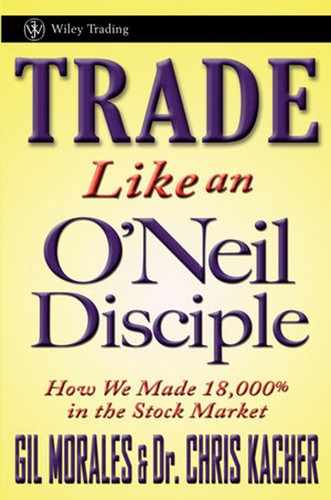1.9. PIVOTAL POINTS VERSUS PIVOT POINTS
Buying at the exact right point is a key mechanic in the O'Neil methodology, and O'Neil's concept of a "pivot point" is drawn from Livermore's "pivotal point," of which Livermore had a "reversal pivotal point" and a "continuation pivotal point." We might consider O'Neil's pivot point buy points in stocks, generally defined by breakouts to new price highs, as more in keeping with Livermore's concept of a "continuation pivot point," whereas O'Neil's concept of a "follow-through day" as confirming an upturn in the market after a prior correction or bear market to be similar to Livermore's "reversal pivotal point" since it indicates a reversal in the market's trend from bear to bull phase. In How to Trade in Stocks by Jesse Livermore and How to Make Money in Stocks by William O'Neil, both writers share a common regard for such a "pivot" or "pivotal" buy point as the exact point where the risk/reward equation is most in the investor's favor, where the ducks are lined up in a row, so to speak, and so the stock should be bought once the price reaches this key pivot/pivotal point.
Waiting for the pivotal point to present itself requires patience, and Livermore would do his best to avoid taking action until and unless the correct pivotal point signal was given, because this assured his success, as he puts it, "Whenever I had the patience to wait for the market to arrive at what I call a 'Pivotal Point' before I started to trade, I have always made money in my operations. Why? Because I then commenced my play just at the psychological time at the beginning of a move" (How to Trade in Stocks [Greenville: Traders Press, 1991], 43). O'Neil says, "The winning individual investor can afford to wait and begin buying at these precise pivot points. This is where the real move starts and all the exciting action originates" (How to Make Money in Stocks, 2nd ed. [New York: McGraw-Hill, 1995], 164). The correct buy point lies at what both O'Neil and Livermore saw as a "line of least resistance," where the stock was "in the clear" and able to launch higher with little to no impediment.
The point of buying right is to enter a stock right at the point where the real move begins, so that if a stock is trading at 50, but the correct pivotal point is at 55, one must still wait for the stock to trade at the higher price if it is determined that this is where the line of least resistance lies. In this way, neither O'Neil nor Livermore were interested in capturing the movement between 50 and 55 as the stock approached the 55 pivotal point, but rather the "big move" from 55 to 100. As O'Neil says in How to Make Money in Stocks, second edition, "Your object is never to buy at the cheapest price or near the low but to begin buying at exactly the right time. This means you have to learn to wait for a stock to move up and trade at your buy point before making an initial commitment" (p. 165). In Chapter 6, we take the concept of pivot and pivotal points further.
